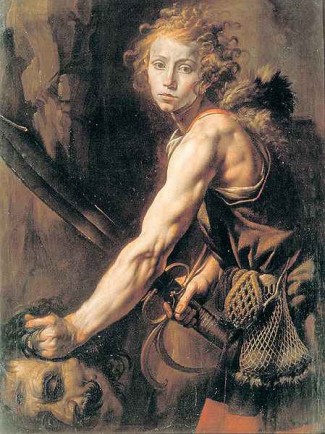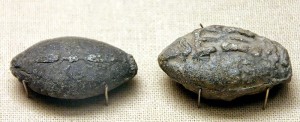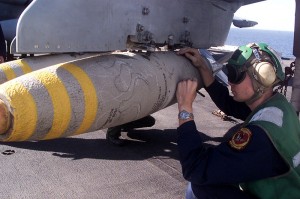 Something is curiously missing in most Old Master paintings of David and Goliath. The famous story from the Old Testament focuses on David’s feat of killing a nine-foot-tall warrior kitted out in mail armor with just one, perfectly aimed slingshot.
Something is curiously missing in most Old Master paintings of David and Goliath. The famous story from the Old Testament focuses on David’s feat of killing a nine-foot-tall warrior kitted out in mail armor with just one, perfectly aimed slingshot.
Yet when 16th and 17th century artists went to paint this story of the biblical underdog, they seldom bothered to portray the weapon system that took down Goliath. (Or if they did, they snuck it onto the canvas unobtrusively, as Tanzio da Varallo did in his 17th century portrait of David above.)
For the most part, however, these painters preferred to depict David wielding a shiny sword, just after he had beheaded his opponent. Why is that?
The sling, it appears, seemed far too humble and archaic a weapon for heroics in Renaissance Europe. By the 15th century, European armies employed other long-range weaponry for their deadly work: bows, crossbows and even throwing axes. The sling had been all but forgotten, relegated to the countryside, where shepherds guarded their flocks from wolves.
But these early weapons were nothing to mess with–something that first struck me a few weeks back while I was researching a story on ancient warfare on North America’s northwest coast. There Native American combatants fired slingstones the size of small cannonballs with force enough to split massive wooden war canoes in half. Who would have thought?
 I’ve since discovered that ancient Greek and Romans slingers left nothing to chance. They cast special lead bullets, shaped like almonds and designed to penetrate armor, for their slings. Such standardization allowed these soldiers to refine their skills. “Only with identical ammunition can a slinger begin to hone his aim,” writes Paul Elliot, a dedicated modern slinger.
I’ve since discovered that ancient Greek and Romans slingers left nothing to chance. They cast special lead bullets, shaped like almonds and designed to penetrate armor, for their slings. Such standardization allowed these soldiers to refine their skills. “Only with identical ammunition can a slinger begin to hone his aim,” writes Paul Elliot, a dedicated modern slinger.
Archaeologists have collected sling bullets from battlefields around the ancient world, from Crete to Rome. And what I find interesting is that many bear inscriptions–personal messages to their victims. Often these take the form of taunts, commands or a kind of swaggering battlefield humor: “Take that,” “This is yours,” or “Ouch.”
 Strangely enough, this has become an enduring military tradition. During the invasion of Afghanistan and the targeting of al-Qaeda bases, American flight crews inscribed their bombs with messages such as “I love New York,” “FDNY” (or Fire Department New York), and “Terrorism is punishable with Bad Karma.”
Strangely enough, this has become an enduring military tradition. During the invasion of Afghanistan and the targeting of al-Qaeda bases, American flight crews inscribed their bombs with messages such as “I love New York,” “FDNY” (or Fire Department New York), and “Terrorism is punishable with Bad Karma.”
Perhaps we humans finding killing from a distance inherently unsatisfying. Or maybe there’s something in our psyche that craves personalizing such lethal force, showing ourselves and delivering one final message.
Photos and Illustrations: Top, “Davide e Golia” by Tanzio da Varallo; Middle, Ancient Greek sling bullets in the British Museum, courtesy Jastrow; Bottom, An American soldier scrawls a message to terrorists on the surface of a 500 pound MK82 bomb, courtesy the United States Marine Corps.
Being pedantic here: the most famous Renaissance David holds a sling over his shoulder and a rock in his other hand. I know this because I’ve spent hours and years mooning over him.
Good point, Ann! And I agree that Michelangelo’s David is drop dead gorgeous and well worth mooning over. But most of the Old Masters weren’t too interested in depicting the sling in their portrayals of David and Goliath.
I would like to be subscribed to your (Heather) weekly article for lastwordonnothing-
I’ve filled out the subscribe area but never
receive it by email. Please subscribe the email address above. Sallie sallieanddoug@yahoo.com